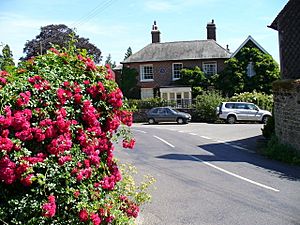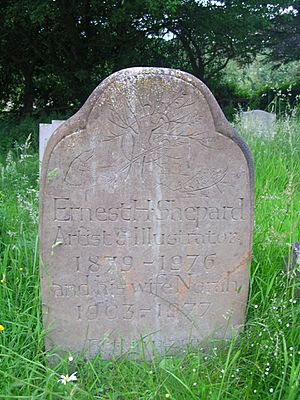E. H. Shepard facts for kids
Quick facts for kids
E. H. Shepard
|
|
|---|---|
| Birth name | Ernest Howard Shepard |
| Born | 10 December 1879 St John's Wood, London |
| Died | 24 March 1976 (aged 96) London |
| Battles/wars | World War I |
| Awards | OBE, Military Cross |
| Other work | Artist and book illustrator of The Wind in the Willows and Winnie-the-Pooh |
Ernest Howard Shepard (December 10, 1879 – March 24, 1976) was a famous English artist. He was also a talented book illustrator. He is best known for drawing the animal and toy characters in two very popular children's books: The Wind in the Willows and Winnie-the-Pooh. His drawings helped bring these beloved stories to life for many readers.
Contents
Ernest Shepard's Artistic Journey

Ernest Shepard was born in St John's Wood, a part of London. He showed a talent for drawing early on. He went to St Paul's School, where his artistic skills grew. In 1897, he decided to study art seriously. He enrolled at the Heatherley School of Fine Art in Chelsea.
Early Art Education and Success
After a successful year at Heatherley, Shepard continued his studies. He attended the Royal Academy Schools. There, he won important scholarships and prizes. In 1904, he married Florence Eleanor Chaplin, who was also a painter.
By 1906, Shepard had become a successful illustrator. He created drawings for classic books. These included Aesop's Fables, David Copperfield, and Tom Brown's Schooldays. At the same time, he worked as an illustrator for Punch, a famous British magazine. The couple first lived in London, then moved to Shamley Green in 1905.
Exhibitions and Artistic Recognition
Shepard was a very active painter. He showed his artwork in many exhibitions. He displayed his paintings at the Royal Society of Artists in Birmingham. He also exhibited in Glasgow's Institute of Fine Arts. His work was shown at the Walker Art Gallery in Liverpool. He also had exhibitions at the Manchester Art Gallery.
However, Shepard loved London the most. He exhibited his art sixteen times at the Royal Academy in Piccadilly. His wife, Florence, also showed her paintings in London. She had a modest art career for 25 years.
Shepard's Role in World War I
When World War I started in 1914, Shepard was in his mid-thirties. He joined the army as a second lieutenant. He was part of the Royal Garrison Artillery. In May 1916, his unit went to France. They took part in the Battle of the Somme.
In late 1916, Shepard began a special job. He worked for the Intelligence Department. He sketched the battle areas from his battery's position. This helped the army understand the battlefield. In February 1917, he became an acting captain. He briefly served as an acting major during the Battle of Arras.
Shepard was promoted to lieutenant in July 1917. While serving as captain, he received the Military Cross. This award is given for bravery. His award citation praised his courage. It said he kept observing and sending important information. He did this even under heavy enemy fire.
Later in 1917, his unit fought in the Battle of Passchendaele. They faced heavy attacks and had many casualties. At the end of the year, they moved to Italy. They helped in the Italian Front.
Shepard missed the Second Battle of the Piave River in April 1918. He was on leave in England. There, King George V gave him his Military Cross at Buckingham Palace. He also attended a gunnery course. He returned to Italy for the victory at Battle of Vittorio Veneto. After the war ended in November 1918, Shepard was promoted to acting major. He was in charge of managing captured enemy guns. His unit was disbanded in March 1919.
Return to Punch and Famous Illustrations
Throughout the war, Shepard continued to draw for Punch. In 1921, he became a regular staff cartoonist. He became the lead cartoonist in 1945. However, he left this role in 1953.
In 1923, Shepard was suggested to A. A. Milne, the author. Milne first thought Shepard's style was not right for his books. But he hired him to illustrate a book of poems. This book was called When We Were Very Young. Milne was very happy with the results. He then insisted that Shepard illustrate Winnie-the-Pooh.
Milne knew how much Shepard's drawings helped the book's success. He arranged for Shepard to get a share of the book's earnings. Milne even wrote a special poem for Shepard. It was inscribed in a copy of Winnie-the-Pooh. The poem showed how much he valued Shepard's art.
When I am gone,
Let Shepard decorate my tomb,
And put (if there is room)
Two pictures on the stone:
Piglet from page a hundred and eleven,
And Pooh and Piglet walking (157) ...
And Peter, thinking that they are my own,
Will welcome me to Heaven.
Over time, Shepard sometimes felt that his Pooh illustrations overshadowed his other work. He even called Pooh "that silly old bear."
The Real Pooh Bear
Shepard did not draw Pooh based on the toy owned by Milne's son, Christopher Robin. Instead, he used his own son's stuffed bear, named "Growler." Growler no longer exists today. Shepard's Pooh drawings are so famous. In 1969, when he was 90 years old, 300 of his early sketches were shown. They were exhibited at the Victoria and Albert Museum.
One of Shepard's oil paintings of Winnie the Pooh is very rare. It was painted in the 1930s for a teashop. It was sold for $243,000 in London in 2000. This painting is now displayed in Canada. You can see it at the Pavilion Gallery in Assiniboine Park in Winnipeg.
Shepard wrote two books about his own life. They are called Drawn from Memory (1957) and Drawn From Life (1961). In 1972, he gave his personal collection of papers and illustrations to the University of Surrey. These are now kept in the E.H. Shepard Archive. In 1972, he was also honored. He was made an Officer of the Order of the British Empire (OBE).
Shepard's Family Life
Ernest Shepard lived in St John's Wood, London. From 1955, he lived in Lodsworth, West Sussex. He and his first wife, Florence, had two children. Their son was named Graham (born 1907). Their daughter was named Mary (born 1909). Both of their children also became illustrators.
Sadly, Graham Shepard died in September 1943. His ship, HMS Polyanthus, was sunk during World War II. Mary Shepard married E.V. Knox, who was the editor of Punch. She became famous for illustrating the Mary Poppins children's book series.
Florence Shepard, Ernest's first wife, passed away in 1927. In November 1943, Shepard married Norah Carroll. She was a nurse at St Mary's Hospital. They stayed married until his death in 1976. In 1966, he commented on the short film Winnie the Pooh and the Honey Tree. He called it a "travesty," meaning he thought it was a poor imitation of his work.
Books Illustrated by E. H. Shepard
- 1924 – When We Were Very Young
- 1925 – Playtime and Company; Holly Tree
- 1926 – Winnie-the-Pooh; Everybody's Pepys
- 1927 – Jeremy; Little One's Log; Let's Pretend; Now We Are Six; Fun and Fantasy
- 1928 – The House at Pooh Corner; The Golden Age
- 1930 – Everybody's Boswell; Dream Days
- 1931 – The Wind in the Willows; Christmas Poems; Bevis; Mother Goose
- 1932 – Sycamore Square
- 1933 – Everybody's Lamb; The Cricket in the Cage
- 1934 – Victoria Regina
- 1935 – Perfume from Provence
- 1936 – The Modern Struwwelpeter
- 1937 – Golden Sovereign; Cheddar Gorge; As the Bee Sucks; Sunset House: More Perfume from Provence
- 1939 – The Reluctant Dragon
- 1941 – Gracious Majesty
- 1948 – The Golden Age; Dream Days; Bertie's Escapade
- 1949 – York
- 1950 – Drover's Tale
- 1951 – Enter David Garrick
- 1953 – The Silver Curlew
- 1954 – The Cuckoo Clock; Susan, Bill and the Wolf-Dog
- 1955 – The Glass Slipper; Operation Wild Goose; Crystal Mountain; Frogmorton; The Brownies
- 1955 – Mary in the Country
- 1956 – The Islanders; The Pancake
- 1956 – The Secret Garden
- 1956 – Royal Reflections: Stories for Children
- 1957 – Drawn from Memory; Briar Rose
- 1958 – Old Greek Fairy Tales
- 1959 – Tom Brown's School Days
- 1960 – Noble Company
- 1961 – Drawn from Life; Hans Andersen's Fairy Tales
- 1965 – Ben and Brock
- 1969 – The Wind in the Willows (colour re-illustration); The Pooh Cookbook (cover)
- 1970 – Winnie the Pooh (colour re-illustration); The House at Pooh Corner (colour re-illustration)
- 1971 – The Pooh Party Book (cover)
See also
 In Spanish: E. H. Shepard para niños
In Spanish: E. H. Shepard para niños


